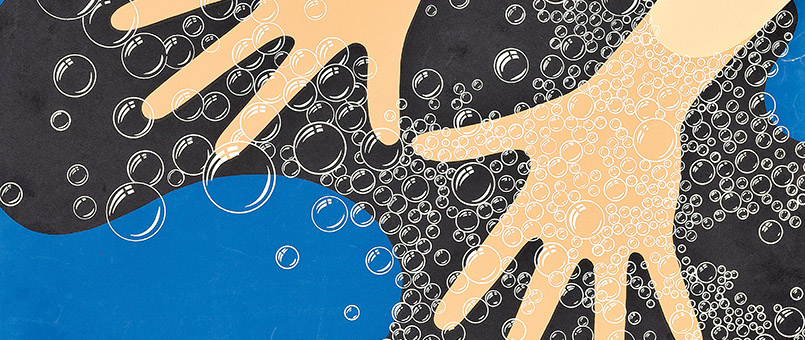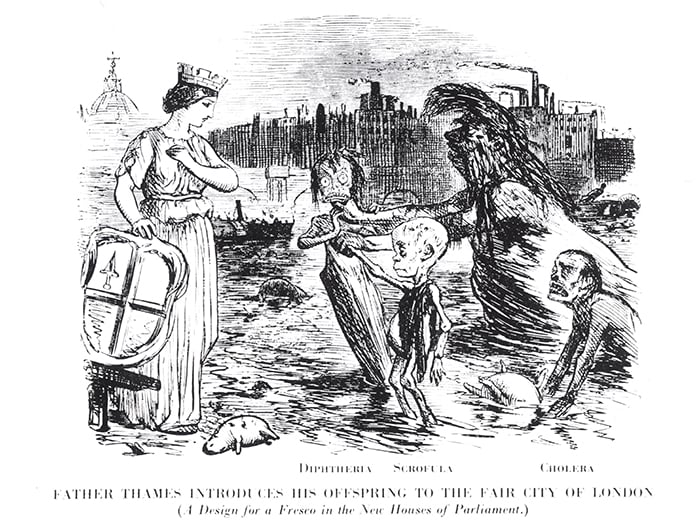
A Great Stink
Toilets. We use them every day. The idea of trying to get by without one is almost impossible to imagine. For many of us flushing a toilet, like turning on a tap, is something we take for granted, but more than 650 million people in the world do not have access to clean water and more than 2.3 billion people do not have access to a safe, private toilet.
Where people don’t have safe water and adequate sanitation, disease spreads fast. Every day, in the world’s poorest communities, people’s health and lives are put at risk. Poor sanitation locks people in poverty, holding back their education and livelihood. With no access to a toilet, women in particular are denied their dignity and safety. Diarrhoea is one of the three most common killers of young children globally, and more than half of these deaths could be prevented by clean water, sanitation and good hygiene.
Earlier this year WaterAid’s Big History Project looked at the UK’s history of sanitation in order to show that change can happen.

Father Thames Introduces his Offspring to the Fair City of London, a design for a fresco in the new Houses of Parliament (engraving) by English School
The Crisis
150 years ago the sanitation crisis in the UK was impossible to ignore. You would have seen and smelt it wherever you went. While the industrial revolution was bringing new jobs and opportunities, our ancestors were paying with their health. As our towns and cities sprawled and business boomed, little thought was given to sanitation. There was no choice but to throw ‘night-soil’ into the street, polluting the environment, and poisoning drinking water.

Water Water Everywhere: And not a drop to drink’ Comment on London water supply during reappearance of cholera in 1848 and 1849. Cartoon from Punch, London, 1849, with a mis-quote from Coleridge Rhyme of the Ancient Mariner. Wood engraving / Universal History Archive/UIG
Disease
Unsurprisingly, disease ran rife. In 1831, cholera came to the UK with a devastating impact similar to the recent Ebola outbreak in West Africa – arriving suddenly, spreading and killing fast, and creating fear and unrest in the cities. It was a deadly problem, recurring frequently over the rest of the century, killing thousands.
After the “Great Stink” of 1858, when the overwhelming smell from untreated sewage in the River Thames forced MPs to leave the Houses of Parliament, it took just 18 days to pass an act to clean up the river. It is amazing what can happen with the right political will!
In 1865 a new sewerage system designed by Sir Joseph Bazalgette was introduced in London. It eliminated water-related diseases like cholera, public health improved and child mortality rates dropped dramatically. The first pumping station opened at Crossness in April that year, marking the beginning of changes to water and sewerage systems across the UK.
As part of the Big History Project, WaterAid also commissioned Thomas Ball to photograph sites of interest in the history of sanitation in London.
Supporting Sanitation Programmes
WaterAid and its partners work to ensure that poor sanitation elsewhere in the world can be relegated to the history books. I observed this first hand just last week when I visited northern Ghana. With the support of HSBC Water Programme, WaterAid Ghana and partners have been able to implement life-changing water and sanitation programmes.
I saw a school in which students now have latrines rather than having to relieve themselves in the bush. I was invited to inspect one household latrine after another as proud home-owners showed me their new facilities and told me about the impact their new understanding of hygiene and sanitation has had on the health of their families.

Left: Amina (left) and Rahama in front of one of the latrine blocks built by WaterAid with funding from HSBC. Credit: WaterAid/ Nyani Quarmyne/ Panos
Right: Hawa Tijani washing her hands at a handwashing station in a block of latrines built by WaterAid with funding from HSBC. Credit: WaterAid/ Nyani Quarmyne/ Panos
Access to water, sanitation and hygiene is a basic human right. These services are essential for good health, for progress in gender equality, for economic development and for our dignity as human beings.
Global Goals
This year all UN member states have adopted new Global Goals on sustainable development. This 15-year framework aims to eradicate extreme poverty and tackle inequalities and climate change by 2030, creating a world that is healthier, fairer and more sustainable.
Goal 6 aims to deliver access to water, sanitation and hygiene for everyone everywhere. Without achieving this goal, the world cannot reach many other goals, such as hunger and malnutrition, gender equality, education and healthy lives for all.
It’s a big ask, but it can happen, because it has happened before. In the UK, Europe, South Korea, Singapore and many other countries, strong leadership, political will and sufficient funding for sanitation have dramatically changed public health and modernised societies.
To get there we need determination and commitment. We need to hold world leaders to account and make them deliver on their promises to reach everyone including the poorest, most vulnerable and most marginalised people in our world.
So, as you celebrate World Toilet Day with a little toilet humour of your own, don’t forget the 2.3 billion people for whom it really is no joke.
Find out More
Get involved with World Toilet Day
Images and Licensing
Using the Categories search tool on the Bridgeman website is a quick and easy way to access the right content for your project. Explore more Science and Medicine images.
Get in touch with uksales@bridgemanimages.com with any enquiries about licensing, research and clearing copyright.
Save
Save
Save
Save


